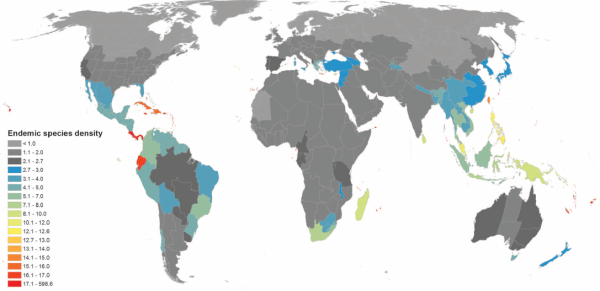Achieving the convention on biological diversity’s goals for plant conservation
September 30, 2013 6 Comments

Endemic plant hotspots of the world (from Joppa et al.)
This paper, which came out 3 weeks ago in Science, assesses the feasibility of the UN Convention on Biological Diversity’s (CBD) goals of protecting 17% of the terrestrial world and, through the Global Strategy for Plant Conservation, 60% of plant species. Using data from a large database of plant species distributions, they show that: a) it is physically possible to achieve these two goals simultaneously (because they were able to find a group of regions comprising 17% of the terrestrial world containing the entire ranges of 67% of plant species); and b) that regions with the most plant species have only slightly more area protected currently than those with fewer species.
I want to start by saying that I think this paper is an important advance in the ‘hotspots’ literature. It identifies regions of high diversity and endemism using an algorithm and data that are transparent and can be updated – an important step forward from previous frameworks based more heavily on expert opinions, as the authors point out.
However, I also feel I must briefly let my grumpy inner economist out of his cage, and reveal myself to the world as a big fan of Hugh Possingham, Steve Polasky, and others who have taken somewhat more pragmatic approaches to the problem of spatial conservation planning. While this paper does an excellent job assessing the physical feasibility of the CBD’s goals, I think it could have, without much extra work, gone much further in addressing other issues affecting the CBD’s practical feasibility.
In particular, I was very surprised to not see the words ‘cost’ or ‘economic’ anywhere in this paper (I even double checked this using command + F after I read through it the first time). As we all know well (e.g. McCarthy’s et al. 2012), conservation initiatives run on a highly limited budget worldwide. It is critical for spatial conservation planning to take this into account if protected areas are going to maximize the biodiversity protected. As a cartoon example, suppose a country has a billion dollars to spend on protected areas and must choose between protecting one area with 30 000 species at a cost of the full billion or two areas of equal size at 500 million each with 20 000 species each. The authors’ greedy algorithm would suggest protecting the first area (with 30 000 species), but more species (40 000) would be protected with the available budget if the cheaper, lower-diversity areas were protected instead. The authors remark that the areas with highest diversity identified by their analysis are not protected in practice much more commonly than areas with lower diversity. I wonder if these lower diversity areas are chosen because they are relatively cheap. The authors’ mention, in the middle column on page 1100, of a bias in protected areas towards high, cold, dry lands that are far from people seems to support this hypothesis.
To suggest that this paper should have formally addressed costs in its analysis is perhaps a bit unfair, as no paper can address everything. However, I do think the authors should have discussed them, even if only briefly. Moreover, I think incorporating costs into the conservation prioritization framework developed here is a highly fruitful area of further research. For example, this paper estimates the minimum area needed to preserve 60% of the world’s plant species. A future study might try to estimate the minimum cost of such conservation. The similar recent analysis by McCarthy et al. on birds provides one example of how this could be done. Combining spatial planning algorithms optimizing for minimum cost and minimum area could yield estimates of an efficiency frontier balancing the two that would be highly useful for policy-makers and spatial planners (see Polasky et al. 2008 for an example of a similar analysis). Some research groups, notably Hugh Possingham’s (I told you I was a fan), have actually already made some promising strides in this direction (e.g. Wilson et al. 2006). I was also quite surprised to not see this or other similar studies cited or discussed by Joppa et al.
I apologize for this somewhat long-winded post, but to conclude, I think this is a good paper that, with a little bit more analysis or discussion of costs, could have been a classic. Nonetheless, I think this study lays the foundation for tremendously fruitful further research in spatial conservation planning.
I have a dirty secret: I love hotspot papers. I love staring at figures like the one above, and thinking about how we live in a world where we can pinpoint where all the world’s diversity is. So bear that in mind.
I think Matt unleashed his grumpy economist a little too early. This is a great hotspot paper. The authors use fundamental biogeographical theory to show why regional data are untrustworthy; I don’t care what form you think the species-area relationship takes, that one exists means the resolution at which the data were collected matters. Yes, there is no explicit costing in this paper, but that is not the point of it – the paper is trying to make a map of endemism, and I think they do a pretty damn good job of it. Although I have serious issues with using endemism as a conservation prioritisation tool, Red Listing all these species would take far too long and so this is probably the best we can do. This is not a paper that is aiming to come up with a robust (economic) prioritisation of the world’s flora, this is a hotspot paper that is trying to figure out where things are and point out the areas of a priori importance. I think Lynsey (below) is right in pointing out that we have a lot of papers like this (here’s another relevant one), and maps of the world’s phyogenetic diversity are beginning to emerge. Indeed, figure 2 plots the number of species protected under various schemes: since we first have to establish whether the species in protected areas would survive without them, and also how much we value those species, I’m not sure what we can do with graphs like this.
The deeper question I think we can all ask is why we need papers like this, and why we shouldn’t just all be out in the field waving placards and setting up reserves. To answer that, I want to talk about when I (briefly) met Lucas Joppa (I think) and Stuart Pimm while doing my MSc at Silwood Park. Felix Whitton and I were running a conservation news website (Conservation Today; the site is dead but check out these talks), and Pimm gave us a ~two hour interview. I specifically remember Pimm saying that it was more important to worry about what was going on “at the coal face” than spend your time making hotspot maps of the world. So why one more hotspot paper for him? Because papers like this give conservation NGOs easy-to-interpret guides (“have you thought about parks in this country, because they have a load of endemics”), and give us an opening to get more money (“hey *insert name of rich person*, this easy-to-understand map that was published in Science says we need more parks here!”). Pimm and others are out there trying to get money to get things saved, and papers like this help them. Fundamentally, it’s not the economic efficiency of a park system that saves wildlife, it’s the product of economic efficiency and the money available.
Another permutation of sub-optimal range data, area-selection algorithms and conservation prioritisation! Rejoice! In all honesty, I wanted to dislike this paper as I feel we are all really going round in circles with these kinds of analyses, but there are things to like in this paper and things to ponder. I also love the style of Joppa, Jenkins et al. (check out this PNAS paper, they are just cutting about other methodologies in a way that is simply fun to read).
Anyways, I am fairly sure that Matt is going to focus on the economic (un)feasability of their conservation guidelines, so I will skip that side of things altogether.
I like that they take actual established guidelines for protected areas and numbers of plant species that need protecting and try and work back from there to establish if they can find the optimal areas that would cover these species numbers in the minimum possible areas. They then show there is substantial overlap with restricted range vertebrate species. All it,well and good. Again, ignoring the economic and political side of protected area designation, do these results tell us much we didn’t know already. A bit…
My biggest concern, and this goes for most such studies, is do we really just want to protect areas with high numbers of species? Don’t we want to conserve ecosystem function or phylogenetic diversity (i.e. a variety of species and a source of new ones)? Don’t we want to make sure that there are corridors for species’ movement and that protected areas are well-connected and likely to be useful in the future? Don’t we want to square conservation goals with existing landuse scenarios and development goals? I am of the opinion that Myers’ hotspots were profoundly important in identifying to scientists and the general public that there are regions with there is a ton more biodiversity than elsewhere, that these are typically beautiful, interesting and probably contain a lot of tapped and untapped resources. Everything since then has (really) just reinforced his original set, perhaps adding a couple more outliers, or more pristine habitats that didn’t make his cut because they hadn’t been screwed up yet. But really tropical areas, islands, some outlier temperate areas are always identified. If you change your criteria, you might get a high latitude region or two. Where do we really want to go from here?
I would say, let’s get campaigning and conserving. Let’s get action happening to protect at least some of these amazing places. Let’s work out what is feasible (politically and economically) and get going.



